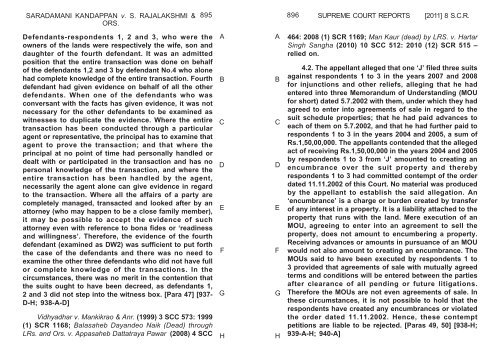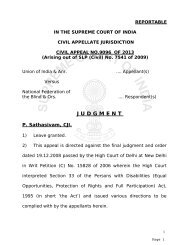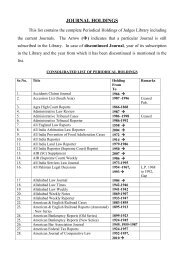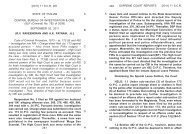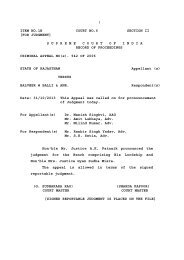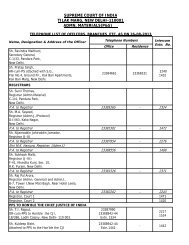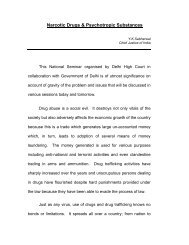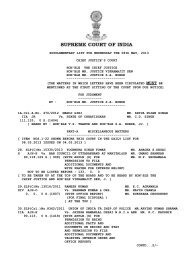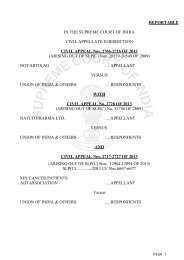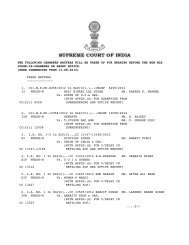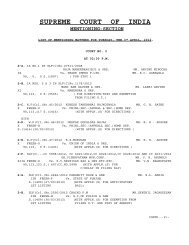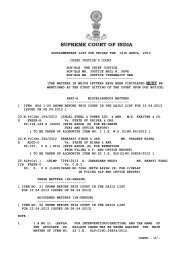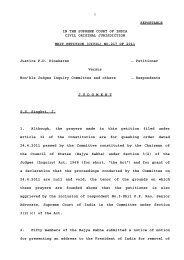Part No.IV - Supreme Court of India
Part No.IV - Supreme Court of India
Part No.IV - Supreme Court of India
You also want an ePaper? Increase the reach of your titles
YUMPU automatically turns print PDFs into web optimized ePapers that Google loves.
SARADAMANI KANDAPPAN v. S. RAJALAKSHMI &<br />
ORS.<br />
Defendants-respondents 1, 2 and 3, who were the<br />
owners <strong>of</strong> the lands were respectively the wife, son and<br />
daughter <strong>of</strong> the fourth defendant. It was an admitted<br />
position that the entire transaction was done on behalf<br />
<strong>of</strong> the defendants 1,2 and 3 by defendant <strong>No</strong>.4 who alone<br />
had complete knowledge <strong>of</strong> the entire transaction. Fourth<br />
defendant had given evidence on behalf <strong>of</strong> all the other<br />
defendants. When one <strong>of</strong> the defendants who was<br />
conversant with the facts has given evidence, it was not<br />
necessary for the other defendants to be examined as<br />
witnesses to duplicate the evidence. Where the entire<br />
transaction has been conducted through a particular<br />
agent or representative, the principal has to examine that<br />
agent to prove the transaction; and that where the<br />
principal at no point <strong>of</strong> time had personally handled or<br />
dealt with or participated in the transaction and has no<br />
personal knowledge <strong>of</strong> the transaction, and where the<br />
entire transaction has been handled by the agent,<br />
necessarily the agent alone can give evidence in regard<br />
to the transaction. Where all the affairs <strong>of</strong> a party are<br />
completely managed, transacted and looked after by an<br />
attorney (who may happen to be a close family member),<br />
it may be possible to accept the evidence <strong>of</strong> such<br />
attorney even with reference to bona fides or ‘readiness<br />
and willingness’. Therefore, the evidence <strong>of</strong> the fourth<br />
defendant (examined as DW2) was sufficient to put forth<br />
the case <strong>of</strong> the defendants and there was no need to<br />
examine the other three defendants who did not have full<br />
or complete knowledge <strong>of</strong> the transactions. In the<br />
circumstances, there was no merit in the contention that<br />
the suits ought to have been decreed, as defendants 1,<br />
2 and 3 did not step into the witness box. [Para 47] [937-<br />
D-H; 938-A-D]<br />
Vidhyadhar v. Mankikrao & Anr. (1999) 3 SCC 573: 1999<br />
(1) SCR 1168; Balasaheb Dayandeo Naik (Dead) through<br />
LRs. and Ors. v. Appasaheb Dattatraya Pawar (2008) 4 SCC<br />
895 896<br />
A<br />
B<br />
C<br />
D<br />
E<br />
F<br />
G<br />
H<br />
A<br />
B<br />
C<br />
D<br />
E<br />
F<br />
G<br />
H<br />
SUPREME COURT REPORTS [2011] 8 S.C.R.<br />
464: 2008 (1) SCR 1169; Man Kaur (dead) by LRS. v. Hartar<br />
Singh Sangha (2010) 10 SCC 512: 2010 (12) SCR 515 –<br />
relied on.<br />
4.2. The appellant alleged that one ‘J’ filed three suits<br />
against respondents 1 to 3 in the years 2007 and 2008<br />
for injunctions and other reliefs, alleging that he had<br />
entered into three Memorandum <strong>of</strong> Understanding (MOU<br />
for short) dated 5.7.2002 with them, under which they had<br />
agreed to enter into agreements <strong>of</strong> sale in regard to the<br />
suit schedule properties; that he had paid advances to<br />
each <strong>of</strong> them on 5.7.2002, and that he had further paid to<br />
respondents 1 to 3 in the years 2004 and 2005, a sum <strong>of</strong><br />
Rs.1,50,00,000. The appellants contended that the alleged<br />
act <strong>of</strong> receiving Rs.1,50,00,000 in the years 2004 and 2005<br />
by respondents 1 to 3 from ‘J’ amounted to creating an<br />
encumbrance over the suit property and thereby<br />
respondents 1 to 3 had committed contempt <strong>of</strong> the order<br />
dated 11.11.2002 <strong>of</strong> this <strong>Court</strong>. <strong>No</strong> material was produced<br />
by the appellant to establish the said allegation. An<br />
‘encumbrance’ is a charge or burden created by transfer<br />
<strong>of</strong> any interest in a property. It is a liability attached to the<br />
property that runs with the land. Mere execution <strong>of</strong> an<br />
MOU, agreeing to enter into an agreement to sell the<br />
property, does not amount to encumbering a property.<br />
Receiving advances or amounts in pursuance <strong>of</strong> an MOU<br />
would not also amount to creating an encumbrance. The<br />
MOUs said to have been executed by respondents 1 to<br />
3 provided that agreements <strong>of</strong> sale with mutually agreed<br />
terms and conditions will be entered between the parties<br />
after clearance <strong>of</strong> all pending or future litigations.<br />
Therefore the MOUs are not even agreements <strong>of</strong> sale. In<br />
these circumstances, it is not possible to hold that the<br />
respondents have created any encumbrances or violated<br />
the order dated 11.11.2002. Hence, these contempt<br />
petitions are liable to be rejected. [Paras 49, 50] [938-H;<br />
939-A-H; 940-A]


